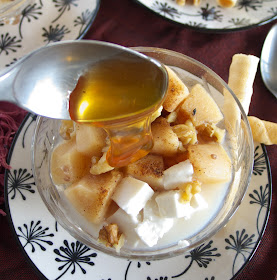Last week I touted my apple recipes for fall. But, let’s not forget that other autumnal fruit, the quince. Less widely-known, but nearly as versatile as apples, quinces are spice-scented, but not very edible in their raw stage. Their tough skins are rich in pectin, the substance that jells jellies.
In Spain, quince—membrillo—is popular as dulce de membrillo, a thick, sliceable paste made by cooking the fruit pulp with sugar. Store-bought quince paste is a super ingredient for making quickie sauces, desserts and sorbets (see recipe links at the end of this post). Quince paste goes well with cream cheese or aged cheese, so include it on a cheese board.
Once cooked, fresh quinces add delicious fruitiness to both sweet and savory dishes. Start with a basic compote, puree it for a spiced sauce.
 |
| Simple, unsweetened quince compote is enhanced with cinnamon and honey, served with walnuts and diced queso fresco, fresh white goat cheese. |
 |
| A very autumnal dinner--loin of wild boar with spiced quince sauce, broccoli and squash on the side, a robust Ribero del Duero tinto and even a few roasted chestnuts. |
 |
| Turn the basic quince compote into a spicy quince mayonnaise to accompany fried cheese balls. |
Quince Compote
Compota de Membrillo
 |
| Quince is cooked unsweetened. A drizzle of honey turns it into a sweet dessert. |
 |
| Cooked quinces. |
Quince has a notoriously tough and leathery skin, making it a bitch to peel. To facilitate peeling and chopping, cook the whole fruit in water for 15 minutes. Drain (save the cooking water, which is rich in pectin). When cool enough to handle, peel the quince, remove the core and chop it.
This compote, made without sugar, can be used for either sweet or savory dishes. Pureed, the compote is the starting point for the two sauces that follow.
Serves 4.
2 medium quinces (8 to 10 ounces each)
1 (2-inch) cinnamon stick
3 cardamon pods
½-inch piece of ginger
¼ lemon
Ground cinnamon, to serve
Honey, to serve
Queso fresco or yogurt, to accompany
Walnuts, to accompany
Cook the whole quinces in boiling water for 15 minutes. Peel, core and chop them. Put them to cook in water to cover (you can use the same cooking water) with the cinnamon stick, cardamom, ginger and lemon. Cook the quinces until they are soft enough to mash with a fork, about 30 minutes. Remove the quince with a slotted spoon. Discard the spices and lemon. Save the cooking water.
Serve the quinces, warm or chilled, in dessert bowls with a little of their juice, sprinkled with ground cinnamon. Accompany with honey, cheese or yogurt, and walnuts.
Spiced Quince Sauce
Salsa Especiada de Membrillo
 |
| Spiced quince sauce is even better than apple sauce with pork. |
Use the quince compote, above, for this fruity, spicy sweet-sour sauce. The sauce goes well with roast pork, duck, venison, turkey or, for vegetarians, a nut-grain loaf. Or, just serve it to accompany aged Manchego cheese and crackers.
1 ½ cups chopped and cooked quince
Quince cooking liquid
2 tablespoons olive oil
¼ cup finely chopped shallots
½ -inch piece of peeled ginger, chopped
1 clove chopped garlic
¼ teaspoon black peppercorns
1 clove
¼ teaspoon coarse salt
¼ cup dry Sherry
1 tablespoon honey
1 tablespoon Sherry vinegar
 |
| Flecks of spices in puree. |
Puree the cooked quince with ¼ cup of the cooking liquid.
Heat the oil in a saucepan and sauté the shallots, ginger and garlic until very soft, but not browned, 8 minutes. In a mortar, crush the peppercorns and clove with the salt. Stir them into the shallots. Add the Sherry and cook off the alcohol, 1 minute. Stir in the honey and vinegar. Add the quince puree. Cook the sauce until thickened, stirring frequently, until thickened, 10 minutes. (If too thick, add additional quince water.)
Serve the sauce hot or room temperature.
Fried Cheese Balls with Quince Mayonnaise
Bolitas de Queso con Salsita de Membrillo
 |
| Fry cheese balls in olive oil. |
These little cheese balls are an easy appetizer food. Serve them speared on picks for dipping in the quince sauce. To serve as dessert, omit the pepper and cumin and serve the cheese balls with honey and quince compote.
 |
| Quince mayonnaise. |
For the sauce:
½ cup Spiced Quince Sauce (recipe above)
¼ cup mayonnaise
Mix the quince sauce and mayonnaise until smooth. Chill until serving time.
For the cheese balls:
Use any melting cheese such as Manchego, Gruyère, Cheddar. For frying, use enough oil to reach a depth of ½ inch. Moderate the heat so the cheese balls do not brown too quickly, as they need to cook all the way through. Olive oil used for frying can be strained and used again.
The cheese balls, once formed, can be frozen in one layer, then transferred to a freezer bag for storage. Allow them to defrost an hour before frying.
Makes 20 (1-inch) balls
1 egg, lightly beaten
10 ounces grated cheese (approx. 3 ½ cups)
½ cup flour
¼ teaspoon baking powder
¼ teaspoon salt
Freshly ground black pepper
¼ teaspoon cumin seeds (optional)
Olive oil for frying
Combine egg, cheese, flour, baking powder, salt, pepper and cumin, if using, in a bowl. Mix with a wooden spoon or hands to form a smooth dough. Pinch off small pieces of the dough, compress to squeeze out air, and roll them into 1-inch balls. Place on a baking sheet lined with parchment.
Heat oil in a deep skillet. Add a layer of cheese balls and lower the heat to medium. Fry the balls, turning frequently, until they are browned on all sides, about 3 minutes. Remove with a skimmer and drain them on paper towels.
Serve the cheese balls immediately with the quince-mayonnaise sauce.
More recipes with quince:


































